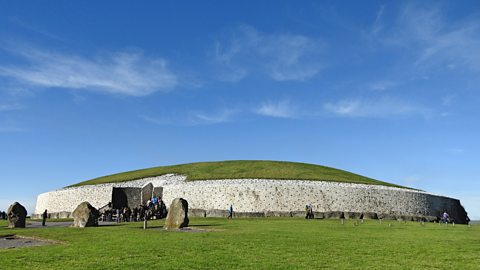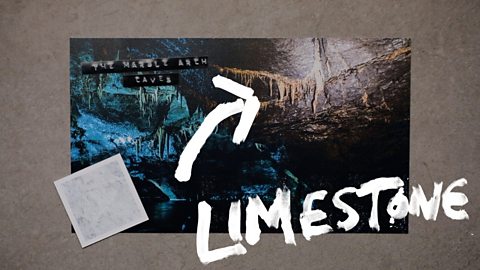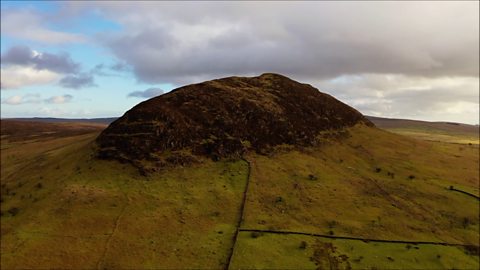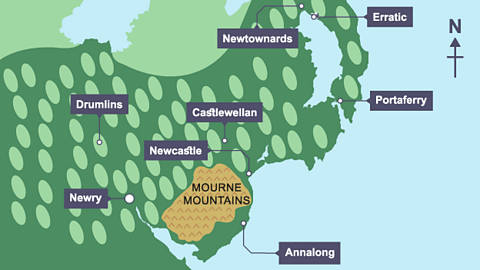What type of rocks?
Different rock types and formations have created some of Northern Ireland’s most beautiful places such as the Mournes and the Marble Arch Caves.
In Northern Ireland, we have a diverse range of rock forms. Basalt rock comprises most of County Antrim’s geological map, while sandstone and slate comprise most of Down and some of Armagh. In fact, if you look at a geological map of NI, you could think county borders were drawn depending on what rock was underneath. The only exception to the rule is Country Tyrone which has a bit of everything - clay, basalt, gabbro, granite, schist, limestone, and sandstone.
It is almost as if each county is sponsored by a rock - Derry by slate, Antrim by basalt, Down by sandstone, Fermanagh by limestone!
Sedimentary and metamorphic rocks

Although all rocks might start out as igneous rocks, some of these rocks are then broken down into smaller pieces. These tiny broken rock particles, float in water and often find their way downstream, settling on the bottom of lakes, rivers and seas. Over time, sediment builds up on these beds in horizontal layers and pressure from above creates a powerful force that pushes down on the lower layers of sediment. These sediments become compacted to form a new type of rock called sedimentary rock. Think of it as recycled rock that has been pushed together to form a new material.
Metamorphic rocks are also formed because of change in their environment - they are created by great heat or pressure transforming other rock types. For instance, hot, molten lava underground can heat up nearby rocks and change them into metamorphic rocks. The process does not melt the rocks - the minerals they contain are changed by heat causing the transformation. The other scenario when metamorphic rock can be formed is when great pressures cause rocks to change from one form to another.
These transformations of rocks into sedimentary and metamorphic rocks does not happen overnight - in fact, earth processes change rocks from one type to another through geological time, which is millions of years! The slow continuous process of rock transformation is called the rock cycle.

Granite from the Mournes
If you have ever walked on the Mourne Mountains, you’ve walked on granite. It is what these wonderful mountains are composed of. Mourne granite especially, has a special and enduring history on this island.

Image caption, Newgrange, a prehistoric tomb built during the Neolithic period, approximately 5200 years ago, used Mourne granite to build some parts of the burial chambers.
Image caption, It was used to build the Mourne Wall between 1904 and 1922, which was constructed to enclose the catchment area for the newly developed Silent Valley Reservoir. The wall is 22 miles long and is now part of a popular walking route in the Mourne mountains.
Image caption, For centuries millstones have been cut in the Mournes. After investigations in 1999, the earliest known tidal mill in the world was discovered at Nendrum, dating from around 1600 years ago the mill stone was traced back to a quarry in the Mournes.
Image caption, Cities such as Liverpool, Belfast, London and Manchester used to pave their streets with granite from the Mournes because it was renowned for its hardness and its polished look over time.
Image caption, Many statues and buildings, including the Parliament Buildings at Stormont were built using Mourne granite – English Portland stone was placed on a Mourne granite base.
Image caption, In 1900 a large memorial stone of Mourne granite was placed on the burial place of Saint Patrick.
1 of 6
Why do we put slate on the top of houses?

Slate is a rock composed of very fine grains, which are called sediments, that became compacted together after being deposited at the bottom of lakes and oceans. These grains are transformed by great pressure into slate - a much harder rock. Slate is a metamorphic rock formed when shale is exposed to high pressure, deep beneath the earth’s surface.
Slate has many characteristics which have made it a good option to roof our houses:
- layers - which make it very difficult to break
- durable - it can last hundreds of years
- cost effective - you will not need to reroof in your lifetime
- fire and mould resistant
- low water absorption - reduces the risk of frost damage
Limestone and the Marble Arch Caves

You may know what a cave looks like, but can you define it? A cave is a natural underground chamber and the Marble Arch Caves, are a series of caves over a 11.5 kilometre area in County Fermanagh. These caves were formed in a variety of ways - one of which was by water flowing through the rock and then slowly dissolving away. Like most caves in the world, the Marble Arch Caves are situated in a limestone area.
Limestone is a sedimentary rock made up of bits of animal shells compacted together over millions of years. As you would expect, many limestone deposits contain fossils of ancient animals and plants. Although limestone is a strong rock, it has particular characteristics which mean it is susceptible to corrosion. The limestone in the Marble Arch Caves formed around 330 million years ago.
The corrosion over time created a network of underground limestone caves. As well as the natural passages, this process also created cone shaped rocks that have taken millions of years to form called stalactites and stalagmites. The stalactites look like spiked up hair turned upside down and were formed by water dripping off the edge of the limestone. What is amazing about the caves is that they are still forming, depositing and changing shape right in front of our eyes.

Test yourself
More on Rocks
Find out more by working through a topic
- count3 of 3

- count1 of 3
